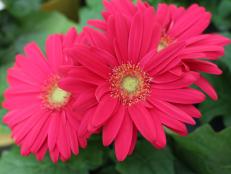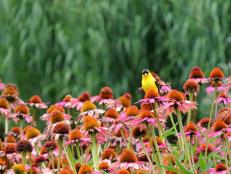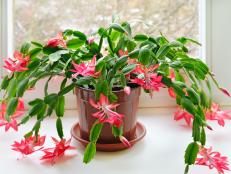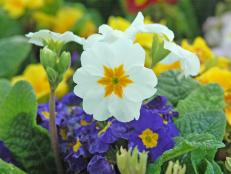Daisy Mums

Fill your garden—and your favorite vases—with the cheery flowers of daisy mums. These happy-go-lucky bloomers give a familiar floral face a makeover by expanding the color palette and petal form. Daisy chrysanthemums are a type of garden mum, known botanically as Chrysanthemum x morifolium. Like other garden mums, most daisy mums are perennials, hardy in Zones 5 to 9.
Daisy mum flowers fall into three chrysanthemum classes—singles, semi-doubles and spoons. These classes refer to the floret or petal number and shape. Single daisy mums resemble the common roadside daisy of he-loves-me-he-loves-me-not fame, with a flat center disk surrounded by single row of colorful petals.
Semi-doubles have almost twice the number of petals—they’re not fully double, but just semi, and still have the fully visible flat disk center. (In a fully double flower, the center disk isn’t visible but becomes overtaken with petals.) Spoon daisy mums bring quirky fun to the garden with their unusual petal shapes. The flower is a single type, and the petals have a spoon-shaped end. Each petal has almost a rolled or tubular look to it.
You can find a wide variety of flower colors in the daisy mum group. Centers on the blossoms are most often a bright golden yellow, while the color range runs from quiet pastels to fiery fall shades. Daisy mum shades include white, yellow, red, purple, pink and orange. Two-tone petals are also becoming more available, including blooms having deep rose petals with white edges or golden petals with streaks of bronze. You might see deep-red orange petals with gold tips or orange petals with red stripes.
Variety abounds in the daisy mums. A new introduction blends bright golden petals with a chocolate brown center. Among the spoon daisy mums, flowers open in shades of apricot, bronze, pink, orange and gold. Many spoon mum blooms have a two-toned effect because the spoon often appears a darker hue than the tubular petal.
In the garden, give daisy mums a spot in the sun. The more sun you have, the more flowers you’ll see. Well-drained soil rich in organic matter will keep plants happy and thriving. Provide an organic mulch that will slowly break down and add more organic matter to soil. The mulch also helps to insulate shallow daisy mum roots.
With daisy mums, you can shear plants back until late July to obtain a rounded plant form that’s loaded with flowers. If you want a few larger blooms, allow plants to grow tall and practice disbudding, or removing developing side shoot flower buds. This causes the plant to direct all energy to the remaining one or few flower buds, which results in larger flowers. Taller daisy mums need staking, so keep a supply of bamboo stakes on hands to help hoist plants.
Daisy mums tend to flower in October, with a few of the spoon types flowering in November. If you garden where frost comes in October, you’ll have best results if you grow the later flowering types inside a hoop house.














































